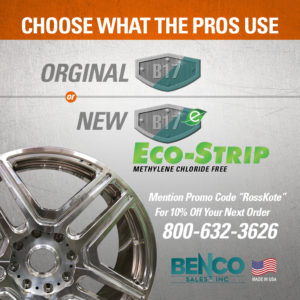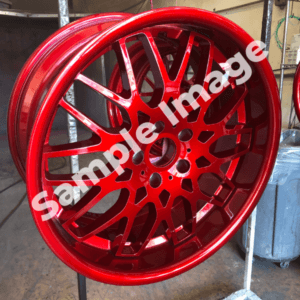RossKote (Kim Scott): Oh, okay. That’s good to know. Okay. I didn’t know that. We’re unique out here in Hawaii and when I was cost comparing the barrel to the five gallon, I didn’t know about these totes. I somehow didn’t even consider that, we actually opted for the five gallon because it was palatable. And we could actually, we couldn’t really get around the shipping. Shipping is just shipping here in Hawaii. And so we actually opted for I think we bought 30 or 45 gallons.
Benco (Valeri Lennon): Yeah for a bigger pallet it’s 32.
RossKote (Kim Scott):Yeah, 32. Yeah. And they palleted, wrapped it.
RossKote (Kim Scott): It didn’t get damaged in shipping. And I think that says a lot about your company too, is the way that you make sure that a everything was wrapped. Cause I tell you, I order a lot of stuff from the main land, whether it’s a metal equipment or anything, and some of the stuff that just comes here and, it just gets damaged in shipping.
RossKote (Kim Scott): And I was so worried about this product coming here because of what it was. And it just came so quickly. It was still that all the wrapping and shipping was in intact not disturbed at all. Nothing had spilled, nothing was broken, nothing was punctured. It was just awesome. And it was a big relief.
RossKote (Kim Scott): Because I didn’t want any of the shippers getting hurt or anybody in between all that. Like what’s this product and who’s this company and everything like that, so I was really excited that you guys took the time to wrap it just right.
Benco (Valeri Lennon): Safety is key. We try to culture our customers, and I want all my employees to be safe. We all want good things to happen for everybody. And if they’re buying B 17, it’s going to help them make money. But it’s all about keeping it safe before it even begins.
RossKote (Kim Scott): Yeah. And I think that’s a really valuable core thing that you just said, because I think that maybe.
RossKote (Kim Scott): The buyer knew how much safety and attention to detail that you guys do. They probably wouldn’t take better care of themselves as well, just bleeds into itself. So it’s good that we’re talking about this because I don’t think a lot of users maybe that get burns more frequently if they knew how important it was, from how serious you take that.
RossKote (Kim Scott): And there’s, the user’s safety and wellbeing, may be they would probably pay a little bit more attention to safety. Let’s continue on with best practices. Oh, go ahead. Yes.
Benco (Valeri Lennon): Oh, good. In fact, I was going to talk about that. I was going to say another important thing to consider when you use these B 17 is you must have proper ventilation.
RossKote (Kim Scott): Yeah, exactly. Set up and proper ventilation.
Benco (Valeri Lennon): Yes. We’d like to tell people too, because them ethylene chloride vapors are heavy and you will lose some as your stripping is going on. You will lose some, and sometimes it’ll float over the top of your strip tank and down to the ground.
Benco (Valeri Lennon): That is where your vapers are. So you want to think of silt in water. You want to gently roll them out of your workspace and preferably into the fresh air because they just vaporize and become inert. And just roll them out. If you over fan them, then you’re putting them up into your breathing space and you don’t want to do that.
RossKote (Kim Scott): So are you recommending some kind of over head ventilation? If you are working in a small space, then I would say the main thing is that you have some sort of fan or vent right over your area there. Or if you’re working in an open space, just make enough room to to do all of this work, have this special session in your shop area, where that’s all you’re doing.
Benco (Valeri Lennon): Yes. And actually, because your vapers are rolling to the ground, it’s as simple as putting a box fan at about knee height to roll the vapors out of your work area. Because sometimes if you over ventilate, think of silt and water, you want them to roll out of the way.
Benco (Valeri Lennon): You don’t want them to get forced up into your breathing area by over ventilating them. So just a simple box fan on low helps move them out.
RossKote (Kim Scott): Okay.
RossKote (Kim Scott): That’s good to know. I’ll get my husband on that because I don’t think we have that set up just yet. We are bigger, so we just let the vapers do their thing when he pulls it out.
RossKote (Kim Scott): But I think something simple, like that would be ideal.
Benco (Valeri Lennon): Yes, too many people think they need to suck it up into an overhead ceiling fan or an overhead feeling exhaust, but you’re pulling the vapors up through your breathing area. So that’s not necessarily the smartest way to do it.
RossKote (Kim Scott): Yeah. And we just bought something from Granger.
RossKote (Kim Scott): I was gonna look online. I just bought, he wanted this product. It’s called a spill pallet, we bought it from Granger. I’m not sure if you sell them. It’s back ordered, so I can’t even get it here until like probably the end of the year. But are you recommending something like that? If you have the stripped container, the round barrel one,
Benco (Valeri Lennon): You said a spill pallet?
RossKote (Kim Scott): Yeah, it’s called a spill pallet. This one is 53 by 50 it’s just a giant square.
Benco (Valeri Lennon): I see it. Okay. I just looked it up, I Googled it. I see what you’re saying. Something, that would be a good thing to put under neath your strip tank, especially if you’re in an area where there’s where you don’t have concrete or some of the industrial areas, they’ll have a concrete floor and they’ll have a moat around their strip tank or excuse me, a border around their strip tank.
Benco (Valeri Lennon): So that if there is a spill, it doesn’t go any further than a small confined area. So that actually is a very good idea. And in our B 17 starter kit, we sell the overpack drum with that, which is the same concept, that high density polyethylene, it’s the big yellow 95 gallon overpack drum, where we still have starter kit with that a drum of B 17 and then all the safety gear for just under a thousand dollars.
RossKote (Kim Scott): I didn’t know you sold the whole kit there and maybe that, is that something new or have you always had that? Because I remember considering a metal strip tank buying one of those from you and having it shipped, but I thought, but shipping was going to just be outrageous if I did that.
RossKote (Kim Scott): So we opted for the plastic container.
Benco (Valeri Lennon): Okay. Now we just started that and actually you’ll see that promo on our website. Probably tomorrow, we ran it a while back and it was very popular. And I think it’s a really good way for people to get started.
RossKote (Kim Scott): Yeah, I think it is too. And I think everybody should be, if they’re complaining about getting jobs done on time, maybe they’ve got too many jobs and they can’t get them done fast enough, where sandblasting just cutting it.
RossKote (Kim Scott): This is definitely, it was a game changer for us, but let’s continue on. So what substrates or types of metal can use to use with B 17, any of them, all of them, none of them. What are, what do you have?
Benco (Valeri Lennon): B 17 works really well on if we’re talking wheels, steel, aluminum.
Benco (Valeri Lennon): The only thing that it’s a little bit too aggressive for is if you have a lot of magnesium or softer metals coming through. You need to back down to our B 14, but most wheel refinishers are doing aluminum, alloy wheels, heavy duty, and B 17 is the way to babysit it. When you first start using beef 17, you need to babysit it and check every three to five minutes until you understand how quickly things go.
Benco (Valeri Lennon): So that you don’t have any mishaps, B17 will etch your substrate slightly, but a lot of people love that for re-adhesion. But if you leave something in your B 17 overnight, it’ll look like Swiss cheese in the morning. So that’s why I say you’ve got to babysit it’s you understand it for awhile.
Benco (Valeri Lennon): And then once you get to understand it and you’ve been using it for a while, you can say this wheel is probably going to take 20minutes to 40 minutes, and then you know to check it. Correct? I assume that’s what you guys do.
RossKote (Kim Scott): Exactly. And he’s I don’t know. He’s done enough stripping now where I know, he knows how long it takes.
RossKote (Kim Scott): He doesn’t even have to go back and check it. Now he just puts it on a timer and then, he’s that confident with it and I think it just takes a little bit of time. There’s probably a little bit of a learning curve there. But I agree with you, you just have to learn your product and learn your business using this product. This next question. It was an interesting one because I guess, because we live in the tropics, my husband never really got a heating band, so we actually don’t even use the heat band, but I guess we’re in the tropics. So maybe it’s not as critical as maybe someone that lives in a colder climate.
 RossKote (Kim Scott): And that’s it. And so for powder coaters that don’t meet these minimum requirements is there another product that they can buy or are they just stuck with going to home Depot every time?
RossKote (Kim Scott): And that’s it. And so for powder coaters that don’t meet these minimum requirements is there another product that they can buy or are they just stuck with going to home Depot every time?




